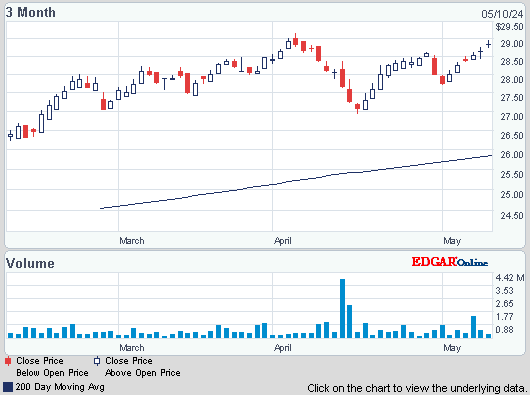Dow dropped 73, decliners over advancers 3-2 & NAZ was up 5. The MLP index fell 2+ to the 445s & the REIT index was off 1+ to the 259s. Junk bond funds inched higher & Treasuries were weak. Oil advanced after retail sales climbed, bolstering the outlook
for the economy of the world’s biggest fuel-consuming nation. Gold is having another bad day in what has been one of its worst years in history.
AMJ (Alerian MLP Index tracking fund)

Applications for unemployment benefits jumped last week from an almost 3 month low, reflecting volatility that typically occurs around the year-end holidays. Jobless claims surged 68K to a 2 month high of 368K, exceeding the highest forecast, according to the Labor Dept. The 300K applications filed in the prior week, which included Thanksgiving, were the fewest since Sep 7. The data reflect seasonal adjustment volatility around the Thanksgiving & Christmas holidays. The forecast called for 320K claims & the 68K increase in applications was the biggest in a year. The monthly average increased to 328K from 322K in the prior week.
Jobless Claims in U.S. Surge in Week After Thanksgiving
Retail sales rose more than forecast in Nov as Americans bought cars & took advantage of discounts going into the holiday-shopping season. Purchases climbed 0.7%, the most since Jun, after a 0.6% advance in Oct that was larger than previously reported, according to the Commerce Dept. The forecast called for a 0.6% advance. Excluding cars, sales rose 0.4%, also more than projected. Higher stock prices, rising home values & stronger job growth have helped buoy consumer sentiment, raising the odds that household spending will rebound from the weakest performance in almost 4 years. Nonetheless retailers aren’t taking chances as they mark down merchandise to spur demand. 8 of 13 major categories showed increases last month. The gains were broad-based & included rising revenue at auto dealers, furniture stores, electronics shops & non-store retailers, including online outlets. Sales at automobile dealers climbed 1.8%, the most since Jun, after gaining 1.1% in Oct. Electronics sales are getting a lift from new Playstation & Xbox consoles that debuted last month. Sales excluding merchants such as food services, car dealers, hardware stores & service stations, used to calculate GDP, increased 0.5% in Nov after posting a revised 0.7% gain the prior month that was the biggest in over a year. Demand at building-material stores increased 1.8%, the most since Jul, indicating the rebound in housing is giving some companies a boost. However, demand at clothing stores fell 0.2%, while receipts at general merchandise stores rose only 0.1%.
Retail Sales in U.S. Increase by Most in Five Months
Foreclosure filings in plunged last month to the lowest level in almost 8 years as investor purchases & an improving economy brought the end of the housing crisis within sight. Default, auction & repossession notices in Nov were sent to 113K properties, a 15% drop from Oct & the biggest monthly decline in almost 3 years, according to RealtyTrac. The surging wave of defaults that led to 7.7M homes seized by banks or sold in the foreclosure process since Oct 2006 may be coming to a close. Foreclosure starts fell 32% from a year earlier to 52K, also the lowest in almost 8 years. The number of homes that got an initial notice declined in 35 states. But 15 states went the other way RealtyTrac said. Bank seizures dropped 48% from a year earlier to 30K, the lowest since Jul 2007.
Foreclosures Drop to Eight-Year Low as Crisis Wanes: Mortgages
Stocks are having another bad day as data showing the economy is improving gives more ammunition for the Fed to begin tapering its bond purchases. This is still a stellar year for the markets with the averages up a good 20%. Despite forecasts about another good year fo the economy, the bulls are more concerned about the Fed continuing to throw money at the market. Yield sensitive securities are feeling the brunt of the selling & will continue to do so even though they have been able to do well when interest rates were higher.
AMJ (Alerian MLP Index tracking fund)
Treasury yields:
U.S. 3-month |
0.07% | |
U.S. 2-year |
0.32% | |
U.S. 10-year |
2.87% |
| CLF14.NYM | ...Crude Oil Jan 14 | ...97.91 | ` ...0.47 | (0.5%) |
| GCZ13.CMX | ...Gold Dec 13 | ...1,226.60 | (2.5%) |
Applications for unemployment benefits jumped last week from an almost 3 month low, reflecting volatility that typically occurs around the year-end holidays. Jobless claims surged 68K to a 2 month high of 368K, exceeding the highest forecast, according to the Labor Dept. The 300K applications filed in the prior week, which included Thanksgiving, were the fewest since Sep 7. The data reflect seasonal adjustment volatility around the Thanksgiving & Christmas holidays. The forecast called for 320K claims & the 68K increase in applications was the biggest in a year. The monthly average increased to 328K from 322K in the prior week.
Jobless Claims in U.S. Surge in Week After Thanksgiving
Retail sales rose more than forecast in Nov as Americans bought cars & took advantage of discounts going into the holiday-shopping season. Purchases climbed 0.7%, the most since Jun, after a 0.6% advance in Oct that was larger than previously reported, according to the Commerce Dept. The forecast called for a 0.6% advance. Excluding cars, sales rose 0.4%, also more than projected. Higher stock prices, rising home values & stronger job growth have helped buoy consumer sentiment, raising the odds that household spending will rebound from the weakest performance in almost 4 years. Nonetheless retailers aren’t taking chances as they mark down merchandise to spur demand. 8 of 13 major categories showed increases last month. The gains were broad-based & included rising revenue at auto dealers, furniture stores, electronics shops & non-store retailers, including online outlets. Sales at automobile dealers climbed 1.8%, the most since Jun, after gaining 1.1% in Oct. Electronics sales are getting a lift from new Playstation & Xbox consoles that debuted last month. Sales excluding merchants such as food services, car dealers, hardware stores & service stations, used to calculate GDP, increased 0.5% in Nov after posting a revised 0.7% gain the prior month that was the biggest in over a year. Demand at building-material stores increased 1.8%, the most since Jul, indicating the rebound in housing is giving some companies a boost. However, demand at clothing stores fell 0.2%, while receipts at general merchandise stores rose only 0.1%.
Retail Sales in U.S. Increase by Most in Five Months
Foreclosure filings in plunged last month to the lowest level in almost 8 years as investor purchases & an improving economy brought the end of the housing crisis within sight. Default, auction & repossession notices in Nov were sent to 113K properties, a 15% drop from Oct & the biggest monthly decline in almost 3 years, according to RealtyTrac. The surging wave of defaults that led to 7.7M homes seized by banks or sold in the foreclosure process since Oct 2006 may be coming to a close. Foreclosure starts fell 32% from a year earlier to 52K, also the lowest in almost 8 years. The number of homes that got an initial notice declined in 35 states. But 15 states went the other way RealtyTrac said. Bank seizures dropped 48% from a year earlier to 30K, the lowest since Jul 2007.
Foreclosures Drop to Eight-Year Low as Crisis Wanes: Mortgages
Stocks are having another bad day as data showing the economy is improving gives more ammunition for the Fed to begin tapering its bond purchases. This is still a stellar year for the markets with the averages up a good 20%. Despite forecasts about another good year fo the economy, the bulls are more concerned about the Fed continuing to throw money at the market. Yield sensitive securities are feeling the brunt of the selling & will continue to do so even though they have been able to do well when interest rates were higher.
Dow Jones Industrials










No comments:
Post a Comment